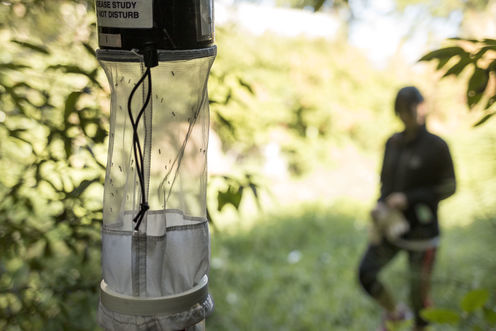
Mosquitoes’ role in the spread of disease make them perhaps one of the most reviled insects in the world. But it also makes them more studied than most of their brethren. Now, a new technique for collecting mosquito saliva from the field has made monitoring mosquitoes both more sensitive and inexpensive.
Mosquito-borne disease remains an intractable problem both in Australia and globally. The seasonal curse of Ross River fever is well known to Australians, as is dengue, which is readily acquired when holidaying in Southeast Asia or even tropical northern Queensland.
Public health warnings and mosquito control remain central to the control of such diseases. But our ability to predict disease outbreaks is hampered by laborious mosquito trapping, underdeveloped forecasting models and unreliable human blood testing.
Good spit
Detecting viruses in wild-caught mosquitoes provides intimate detail of disease transmission cycles, helping us understand the complexities of disease ecology and providing new avenues for predicting and controlling outbreaks. Such virus hunting traditionally involved cumbersome mass collections of mosquitoes shipped live to faraway labs where they were ground up and analysed by scientists to search for traces of viruses.
What’s more, all this effort only showed that a mosquito in that “haystack” was carrying the virus; it couldn’t show whether it was capable of infecting someone with that virus. This, of course, is an important distinction since many mosquitoes can pick up a virus but not pass it on.
But an elegant new technology is helping to improve field detection of viruses, reduce cost and identify only mosquitoes capable of infecting someone with the virus.
A few years ago, Queensland scientists discovered that if trapped mosquitoes could be convinced to spit onto a specially coated card that preserves virus genes (made from DNA and RNA), then the viruses they carry could be more easily detected.
The spat-on cards are processed in a lab where the genes are “amplified” using a process that uses enzymes to probe the cards for virus genes. These genes are then copied, analysed and identified. This is how the concept of the mosquito “spit test” was born.

But how do you get a mosquito to give a saliva sample? Easy. Just coat the card in honey and the mosquito will happily spit while getting a sugar fix. Only mosquitoes with virus in their saliva (rather than in their gut) are detected, thus identifying only the most dangerous (infectious-disease-carrying) mosquitoes.
Thousands of mosquitoes can spit on a single card, meaning much less time and money spent in the lab. And there’s no need for expensive shipments of live mosquitoes. What’s more, the cards can be shipped without refrigeration, making surveillance in remote areas far more effective.
Understanding viral ecology
Initial field trials in Queensland and then the Northern Territory showed viruses could be collected in the field. The idea is now being rolled out in New South Wales, Western Australia and South Australia.
In 2014, an existing mosquito surveillance trapping program in South Australia was modified to retrofit mosquito traps with “honey cards”. When traps were picked up from the field, mosquitoes inside could be seen feeding on the cards. The traps were kept in the lab for a few more days, making sure every mosquito had a chance to provide a saliva sample.
Three virus types (Ross River, Barmah Forest, Stratford) were detected 18 times in the Adelaide region and in River Murray towns, in a year with very little human disease and only moderate mosquito numbers. Sometimes virus was detected in traps with only a small number of mosquitoes present.
This research showed there was perhaps more virus circulating in urban areas than we first realised, and that our understanding of what leads to large disease outbreaks is poorly developed. What we still don’t know is how much virus circulation is “normal”. And how much virus we need to find before sounding the alarm.
Honey cards collecting mosquito spit have the potential to change our perspective on mosquito-borne disease transmission and open up new avenues for enhanced surveillance strategies. Other mosquito-borne viruses such as chikungunya and zika are now threatening Australia, but our surveillance of them is poorly developed.
Using mosquito spit tests could enable early detection of these viruses. And this could help safeguard us from incursions of diseases not yet transmitted here.
Craig Williams receives funding from SA Health, various local governments in SA, and the Adelaide and Mt Lofty Ranges Natural Resource Management Board. Craig is a member of the National Arbovirus and Malaria Advisory Committee for the Department of Health and Ageing.
Emily Johnston Flies receives funding from The Royal Society of South Australia and the University of South Australia.
